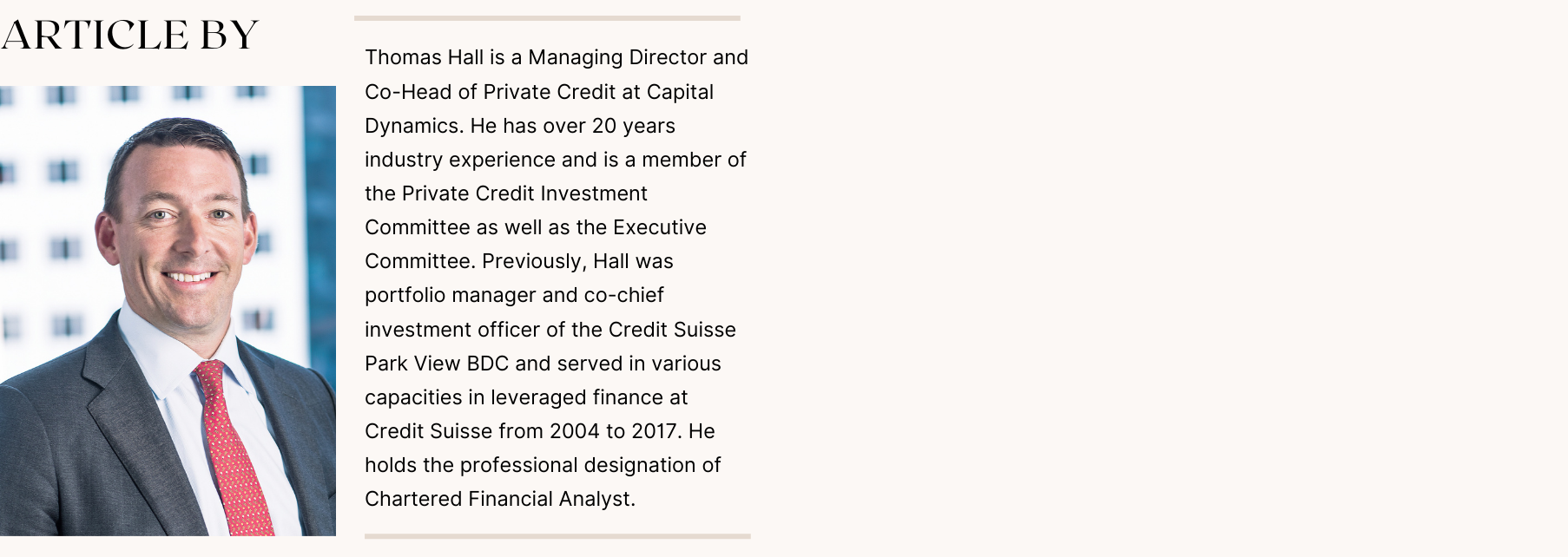How Investors are Reevaluating Their Traditional Allocations so They are Aligned with Current Investment Opportunities
 |
|
The impact of COVID-19, which surfaced in the U.S. over a year ago, continues to shape the global economic backdrop. As a result, many investors have started to reassess their traditional allocations to better align with the opportunity set going forward. For many credit investors, downside protection, capturing incremental yield premium and the threat of rising rates have become top of mind. To meet these goals, many have turned to the private credit asset class, specifically middle-market direct lending, which, in addition to offering these characteristics, has continued to benefit from on-going secular trends. Historically, middle market companies, broadly defined as those with USD five million to USD one billion in revenue, turned to commercial banks for their financing needs. However, over the last thirty years, a combination of regulatory pressure and market dynamics has led to an exodus of commercial banks from the space, and a resulting influx of non-bank entities, or private credit funds, has stepped in to take their place. In 1997, banks provided over sixty percent of leveraged financing and there were more than nine thousand Federal Deposit Insurance Corporation (FDIC)-insured banks. However today, non-bank entities are responsible for nearly ninety percent of leveraged lending and the number of FDIC insured banks has dropped by over half to less than four thousand five hundred.[1] The exit of traditional capital providers combined with the sheer size of the middle market has created a middle-market financing gap, whereby the demand for capital vastly exceeds supply. From a size perspective, if taken as a standalone entity, the middle market would represent the world’s third largest economy. This has created an attractive backdrop for middle market lenders, equipping them with increased negotiating leverage to structure robust credit documents and price deals at a premium to large market transactions. Furthermore, within the middle market, even more attractive pockets of opportunity have emerged. Most middle market lending is focused on larger upper middle market deals. Since 2015, approximately eighty percent of private credit fundraising has been completed by approximately thirty percent of private credit asset managers, resulting in these participants no longer pursuing small deals due to the economics of the transactions and amount of capital they must deploy. Additionally, the trend of consolidation amongst commercial banks has resulted in fewer, but larger, bank participants who must also focus on larger deals. As a result, the lower middle market has emerged as an overlooked and therefore more attractive subset of the non-bank, middle-market lending ecosystem. One key aspect, in addition to more favorable economics, is the enhanced downside protection that the lower middle market enjoys versus the more competitive upper and broadly syndicated loan market, via the inclusion of financial maintenance covenants. These covenants alert lenders to deteriorating financial performance and, if breached, provide lenders with the ability to address the situation. In the competitive broadly syndicated market “cov-lite,” or loans without financial maintenance covenants, have become the standard and today comprise eighty-five percent of all new issue U.S. loans.[2] Additionally, competitive dynamics within the upper middle market; i.e. larger participants with the need to deploy significant dry powder, has allowed “cov-lite” structures to infiltrate that market. Comparatively, lower middle-market credit protections have remained strong, and the recent pandemic served as a real time example of their importance. Generally, lower middle-market direct lending portfolios performed well through the pandemic. However, the impact on certain borrowers was more acute, particularly those requiring in-person interaction. In these situations, borrowing agreements with thoughtfully negotiated covenants helped give lenders an early seat at the negotiating table, the ability to push solutions to protect principal and in some instances enhance economics. As a result, lower middle-market investors were, in many cases, able to drive more positive outcomes for Limited Partners (LPs). In addition to showcasing the importance of downside protection in the form of strong covenants, the pandemic’s impact on monetary policy has further highlighted the attractiveness of the private credit asset class. In the early stages of the pandemic, swift action from the Federal Open Market Committee (FOMC) to cut rates helped underscore the importance of the yield premiums offered to investors in smaller, lower middle-market companies. And while concerns around an uptick in inflation have prompted discussions about potential future Fed action on interest rates, the floating rate nature of the private credit asset class helps provide a helpful duration hedge as the US begins to progress into a post-COVID environment. |
|
Sources:[1] LCD Quarterly Levered Lending Review
[2] LCD Quarterly Levered Lending Review
|
|
|
|
Capital Dynamics is an Associate member of TEXPERS. The statements made in this presentation are for informational and educational purposes only. Any opinions expressed are as of the date of publication, are subject to change and should not be considered as investment advice or as a recommendation of any particular security, strategy or investment product. Follow TEXPERS on Facebook, Twitter and LinkedIn as well as visit our website for the latest news about Texas' public pension industry. |


